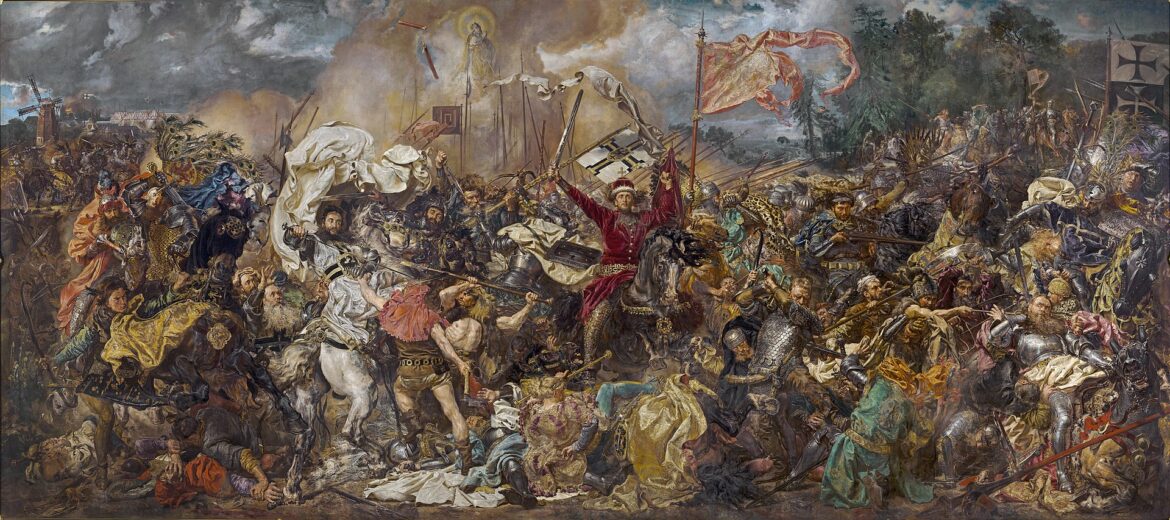On 15 July 1410, on the fields near the village of Grunwald, a battle took place in which the combined knights of Poland and Lithuania broke the armed power of the Teutonic state. Among those who died in the battle was Ulrich von Jungingen, Grand Master of the Teutonic Order.
In 1385, a personal union was concluded between the Kingdom of Poland and the Grand Duchy of Lithuania. The ruler of Lithuania, Jogaila (c. 1352-1434), was baptised, taking the name Ladislaus, and in 1386 married Jadwiga of Anjou, the ruler of the Polish Kingdom. One of the conditions of the concluded agreement was the acceptance of Christianity by Lithuania. The union of the two states became a threat to the neighbouring Teutonic Order.
The Teutonic Knights were brought to the Polish lands by Duke Konrad of Mazovia at the time of the division of Poland into districts. They were to defend Mazovia against the invasions of the pagan Prussians. Within a few decades, the Teutonic Knights managed to build their own state by conquering Prussia. In 1308, they insidiously occupied Polish Gdansk Pomerania, slaughtering the mayor and city councillors and the civilian population in Gdansk. They also burned down the buildings.
Malbork (Marienburg) soon became the seat of the highest monastic authorities with the Grand Master at the head. In 1331, the Polish king Władysław Łokietek (c. 1260-1333) clashed at Płowce with one of the columns of the Teutonic army invading Poland. King Łokietek’s son King Casimir the Great (1310-1370) felt he had to make peace with the Teutonic Knights in order to use the time to strengthen the Polish Kingdom. A treaty was eventually concluded at Kalisz in 1343.
The Teutonic Knights in western Europe justified the sense of their existence in Prussia by the necessity of the armed Christianisation of the neighbouring countries of Samogitia (north-western part of present-day Lithuania) and the Grand Duchy of Lithuania. Lithuania’s acceptance of baptism and union with Poland posed a serious threat to the Teutonic state.
A war, later known as the Great War, broke out between Poland and the Grand Duchy of Lithuania and the Teutonic State in 1409. Its immediate cause was the outbreak of an anti-Teutonic uprising in Samogitia, supported by Grand Duke Vytautas, who ruled Lithuania. A Polish envoy, which arrived in Malbork in 1409, skilfully led Grand Master Ulrich von Jungingen to declare war on Poland.
In mid-August 1409. The Teutonic Knights invaded the bordering Dobrzyń Land and then occupied Bydgoszcz. The city was recaptured by a Polish common squad at the beginning of October 1409. Negotiations began at this time, leading to a truce that lasted until 24 June 1410. Both sides in the conflict began to use this time to prepare their forces for the final showdown. The Teutonic Knights tried to successfully attract knights from western Europe.
In December 1409, King Władysław Jagiełło with his cousin Grand Duke Witold, at a secret meeting in Brześć Kujawski, prepared a detailed plan for the next year’s warfare.
Great hunts were organised to secure meat supplies for the army in Poland. In the vicinity of Kozienice, a folding pontoon bridge, some 500 m long and 2.5 m wide in total, was built in strict secrecy. Its construction was overseen by Radom starost Dobrogost Czarny of Odrzywoł and master carpenter Jarosław. The bridge was floated down the Vistula on 29 June 1410 to the vicinity of Czerwinsk. There, it was assembled in the record time of less than a day. After crossing the Vistula in such a prepared manner, the Polish troops crossed the river in an extremely efficient and organised manner and were soon joined by the Lithuanian army arriving from the east.
The combined army entered the territory of the Teutonic state and marched towards Malbork. This manoeuvre took Grand Master Ulrich von Jungingen completely by surprise.
The decisive clash took place on 15 July 1410 on the fields near the village of Grunwald. The combined Polish-Lithuanian forces, reinforced by Tatar troops, were outnumbering. The Polish King Ladislaus Jagiello did not personally take part in the battle, but according to the eastern art of warfare commanded the whole force from one of the surrounding hills. The Teutonic forces stood in an open field and were exposed to the scorching heat of the hot July day, while the allied troops benefited from the coolness of the backwoods. The battle began around noon with an attack by Lithuanian troops, who, after an hour-long battle, dashed into retreat. Fortunately, the Teutonic forces were fiercely resisted by the Smolensk and Polish troops. In the decisive phase of the battle, the detachment of the Teutonic Knights under the personal command of Grand Master Ulrich von Jungingen tried to strike at the flank of the Polish army, which, however, managed to regroup its forces in time. At this time, the Lithuanian army returned to the battlefield. The battle ended with the victory of the Polish-Lithuanian knights. The Grand Master of the Teutonic Knights himself and many representatives of the Order’s elders were killed in the fighting. In the Teutonic Knights’ camp after the battle, carts full of chains were found, intended for captives to be taken by the Teutonic Knights. King Władysław Jagiełło ordered the body of Ulrich von Jungingen to be sent back to Malbork.
Although the armies of King Władysław Jagiełło and Grand Duke of Lithuania Vytautas later failed to conquer the capital of the Teutonic state, Malbork, the Battle of Grunwald broke the military power of the Teutonic Order. By virtue of the Peace of Toruń, concluded in 1411, Poland regained Dobrzyń Land and Lithuania regained Samogitia. The Teutonic Knights were also to pay a huge ransom for their captives.





